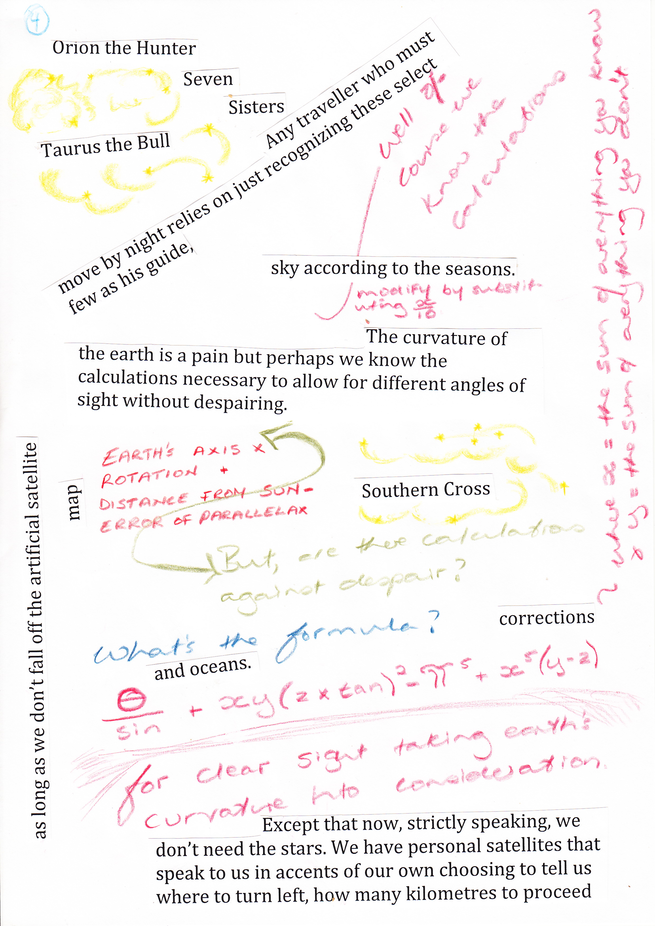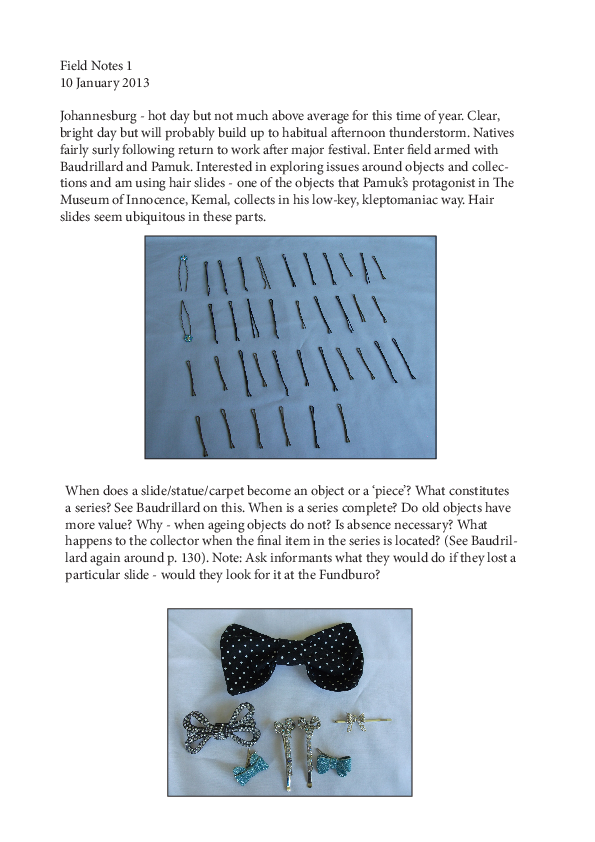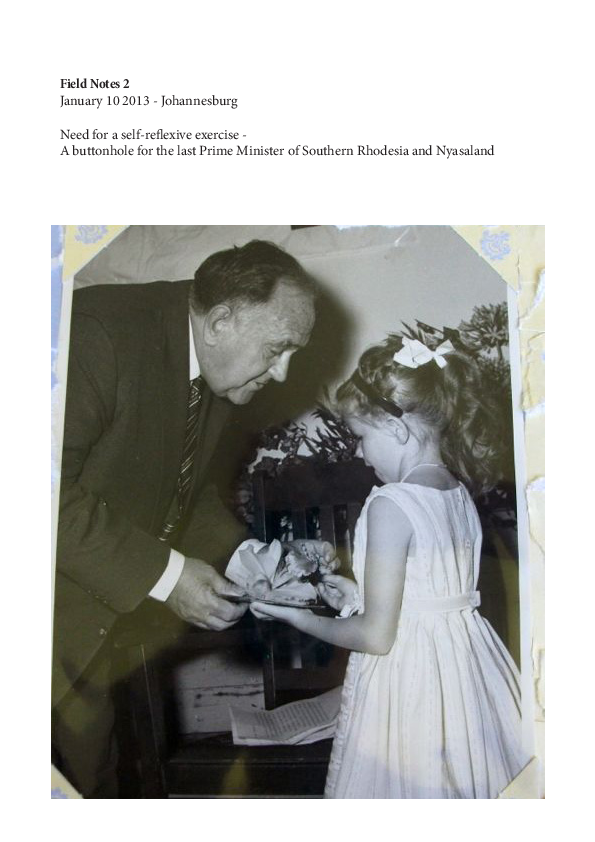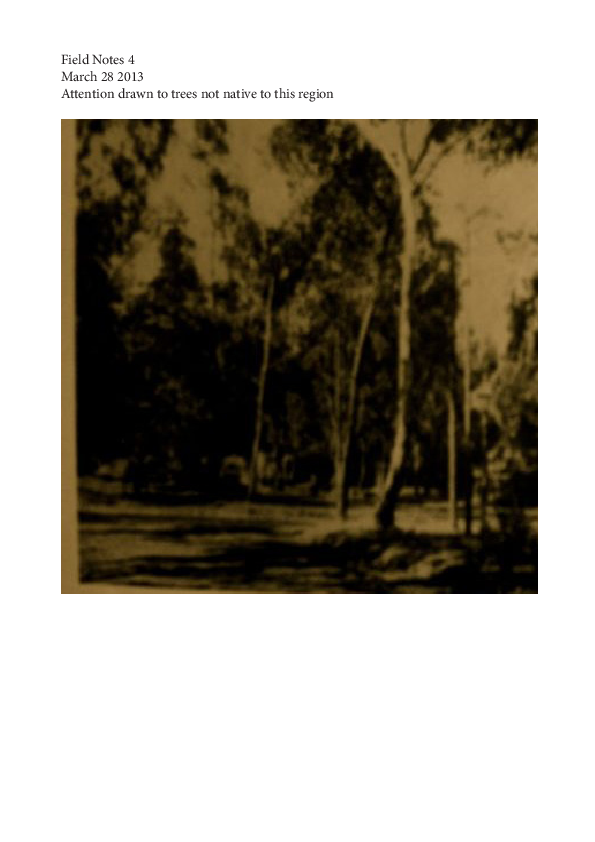This section contains some thoughts on field notes as operating principle and method for FUNDBÜRO, devised in the form of written interviews. We discovered that the practice of addressing field notes to each other as a means of correspondence was a meaningful way to allow each other to intervene in the texts:
Georges: Cynthia Kros joined the project when the founding members of FUNDBÜRO were still talking about objects, their meaning and agency, and the possibility of readings in the context of the modern and its relevance to the arts. As an entry point she felt that the question of distance was an important element (distance from objects as part of FUNDBÜRO inventories, distance as the matter of the research project – how artists and researchers may construe it differently). It seemed obvious to her that she needed to have a closer look at connecting points between objects and people and how these relationships invest the private and the public spheres – a core topic for Bruno Latour, who over three decades studied those who called themselves ‘modern’, and who wrote at least two important works (1994, 2012) that dissected the complex interactions between matter and technology, human and non-human beings. A core problem of the moderns, according to Latour, is the way a scientific and rational mechanism of categorising actually prevents a more complex understanding of the world today. It is actually impossible to separate fields (personal affect, the political, the social, the scientific, the economic, and the spiritual – the object calls for a subject and vice versa). Another approach is called for – one that acknowledges flux and allows for connections/interactions between points rather than definitive mapping of points.
As a researcher who is firmly grounded in theories pertinent to anthropology and history, Cynthia wished to re-explore a tool associated with anthropologists: field notes. These field notes would be considered the device for a mise à distance of the fieldworker with her/his environment, sufficiently informal in nature to allow peripheral observations and ideas to enter, which, in the long run, could become vital in a more global analysis of a given research topic.
Cynthia: I embarked light-heartedly – or perhaps I should say playfully – on a quest to study the moderns in both cities, but particularly Johannesburg, feeling my way towards a methodology, which Latour suggests is quite as difficult and complex as any we might develop to study more remote peoples. I began with the meaning of objects for the moderns and, in particular, their peculiar obsession with collecting, which in turn took me to Baudrillard’s (1968) speculations on the perversity of the relationship between the collector and his collection. Baudrillard’s observation that the collector conducts an amorous relationship with himself through his collection was reminiscent of the conduct of the hero of Orhan Pamuk’s The Museum of Innocence (2009), which I happened to be reading at the time. Pamuk’s protagonist, the self-indulgent and, despite the superficial appearance of devotion, the arch-narcissist Kemal steals everyday objects from the home of his distant kinswoman Füsun, with whom he has become obsessed. At first he uses them to maintain his sense of a connection with her when they are apart and then, eventually, they become the foundation for his museum of the banal, which Pamuk has created in real Istanbul (Pamuk 2012). Pamuk sees himself in revolt against the idea of the modern museum, which celebrates narratives of triumphant nationalism through its exhibition of the lives of exceptional men, war trophies, and architectural wonders. Against the modern narrative of the museum he sets up the trite and the everyday – the kitsch ornament, cigarette butts, and the hair clip – objects that tell of the ordinary lives of individuals, thereby liberating them and their history from the monumental representations that have oppressed and effaced them (ibid.).
I was particularly struck by Kemal’s assertion in The Museum of Innocence that ‘Füsun’s girlish hair clip should remind us that the stories she told happened to a child’ (Pamuk 2009: 55). Notice the formulation of Kemal’s observation about Füsun’s hair clip and the stories she told. He transfers her girlishness to the hair clip, which he then effaces while insisting on it as a marker to remind us that the stories ‘she told happened to a child’ – creating a sense of distance, not only between the stories and the child but between Füsun and the child. It makes me think of the distance between the dreamer and the dream. There’s a passage in Walter Benjamin’s One-Way Street that evokes this distance beautifully. Here’s an excerpt, where he talks about a person who during the morning after a dream is ‘still half in thrall to the world of dream [and who] betrays that world in his words and must expect it to seek vengeance’ (Benjamin 2009: 53). I see now, reading it again, that Benjamin is remarking on how difficult and dangerous it is to tell a dream (and perhaps to tell stories of one’s childhood) without having fully extricated oneself from the experience of ‘the drab twilight of dream’, as he puts it (ibid.: 52). He maintains that one has to reach the ‘other shore’ of ‘bright day’ so that the dream may be ‘addressed from the superior position of recall’ – and further so that the ‘otherworldliness of dream’ becomes ‘attainable’ (Benjamin 2009: 52).
The hair clip struck a particular chord with me because of my own fondness as a child for extravagant hairstyles supported by and decorated with clips and slides. I remembered a particular incident when as a child sleeping on a mattress on the floor of my parents’ bedroom one of my slides dug into my scalp causing me to experience a sharp pain that was like betrayal.
Cynthia: Nowadays anthropologists are encouraged to be reflexive and so, in the course of my study of the moderns, I returned to reflect on myself as a child in the final days of Southern Rhodesia before the war of independence, unconsciously registering the distance that had already opened up between myself and my parents and between their sense of the world and mine; between their sense of the world predicated on a dream of a benevolent colonial order bathed in the warm African sunlight and the rage that was seething all around them.
Cynthia: I think this realisation too made me more receptive to Latour’s quest to find scientific methods for researching the evasive and contradictory moderns. It also made me attentive to Benjamin’s melancholic predictions, coming to me over a distance of more than sixty years, expressed through his sense both that objects were turning against people with unprecedented hostility and that the opportunities for ‘nomadism’ were being extinguished. Benjamin, of course, took his own life because he believed himself to be trapped while in flight from Nazi occupied Paris. Like Kemal/Pamuk, Benjamin derived comfort from kitsch – described as kindly, ordinary objects that didn’t give themselves airs. My most recent field note explores kitsch and the relationship suggested by Apollinaire between – what in French sounds close but in English is so distant that a homophonic association occurs much less readily – la mode and la mort, ‘fashion’ and ‘death’.
Georges: It became evident to Cynthia that the field note would gain in meaning and depth if it were part of a larger series. Like the farmer Lan Lian in Mo Yan’s novel Shengsi Pilao (2006), who with his oxen would plough the field line by line with a keen awareness of the borders, these field notes would, note by note, make the field visible and perceptible. And, as she was writing these field notes, she could explore though them the topic of distance, which, from multiple angles, started to become ‘matter’, embodied and taking on different shapes. These field notes, written in a playful, light-hearted way gained a momentum of their own, which inspired FUNDBÜRO to be tested as a joint way of thinking a research space in development.
Georges: Playfulness: an attitude that allows for creative discovery and the transgression essential in an act of honest research is also a core ingredient to allow successful development of a collective project, as it allows circulation across different fields of knowledge.
Field notes vs automatic writing?
Cynthia: After a presentation given by one of our colleagues at Valence I was given pause to think again about what genre field notes belong to.
At first one might suppose that field notes are the antithesis of automatic writing. Whereas the latter is associated with spontaneity and unexpected juxtaposition, channelled through an author who enters a state of trance as a way of keeping her/his inhibiting consciousness at bay – the field note is presumed to be a matter of recording, transcribing, collecting, and building up a reliable database. Or perhaps one should say, the field note was presumed to be all these things until the interventions of several well-known anthropologists, among them James Clifford. ‘Unlike storytelling,’ Clifford (1990: 63–64) observed, ‘it [writing] cannot be done while walking along a path’. Clifford asks us to consider what happens when we turn away ‘from dialogue and observation’ and head towards the necessarily ‘separate place of writing’ (ibid.: 52). Clifford observes that once we are alone in the tent or the field hut, the process of writing becomes complicated. In the early 1990s he visualised field notes being composed on typewriters, but anticipated that the transition to electronic tools would introduce further complications. Questions are raised including: Are field notes private or addressed, either to some version of ourselves or to a mentor or a future public? Are they original? Often they are not, in the sense that what we are doing is rewriting in response to the voices of our predecessors playing out in our heads. And, therefore – most of all – Are the field notes we compose really under our control? (Clifford 1990: 55).
Some conclusions on field notes:
1. The nature of . . .
The joy of field notes is that they are not the finished product. They don’t have to be edited and can retain the sense we had as we were composing them that we are feeling our way and that our final conclusions can be justly deferred. At the same time, we know that our observations can never be entirely detached from those of our scholarly predecessors and contemporaries (even fictional characters like Kemal). However far we venture, there is some kind of restraint that tugs us back to particular literatures. Consequently, without us being precisely aware of how we are doing it, we create a collage made up of empirical observations, cognitive associations, and creative leaps of faith. It doesn’t matter if the overall effect is a bit rough or the edges where different components meet are ragged. Field notes shouldn’t be judged against the rules of composition.
2. Field notes are written when we are ‘out in the field’.
- As we write them we constitute a ‘field’ out of someone else’s village/city/homestead/encampment and we’re trying to think through the intellectual and ethical implications of doing so. ‘Fields’ of study and ‘fields’ of disciplinary knowledge are usually taken for granted and our larger project (see above) intends to take up the invitation extended by several scholars for us to rethink such fields and imagine possibilities for their reconstitution – perhaps particularly in the global South. In this initial stage of our project, our primary inspiration has been Latour – but we certainly intend to engage with other scholars, especially those writing from Asian and African perspectives.
- We are ‘out’ in the field and thus removed from our own society and its conventions. For Lévi-Strauss, who had good reason to be disenchanted with his home society, this was one of the blessings of an anthropological career (Lévi-Strauss 1992). Of course, in our case, the expedition that takes us far away from our own society and into another is a conceit – we are playing at and with distance. What happens, we ask, when we have to translate across distance and when we have to render the moderns intelligible to our audience without spoiling the sense that the former are exotic and not entirely susceptible to translation?





